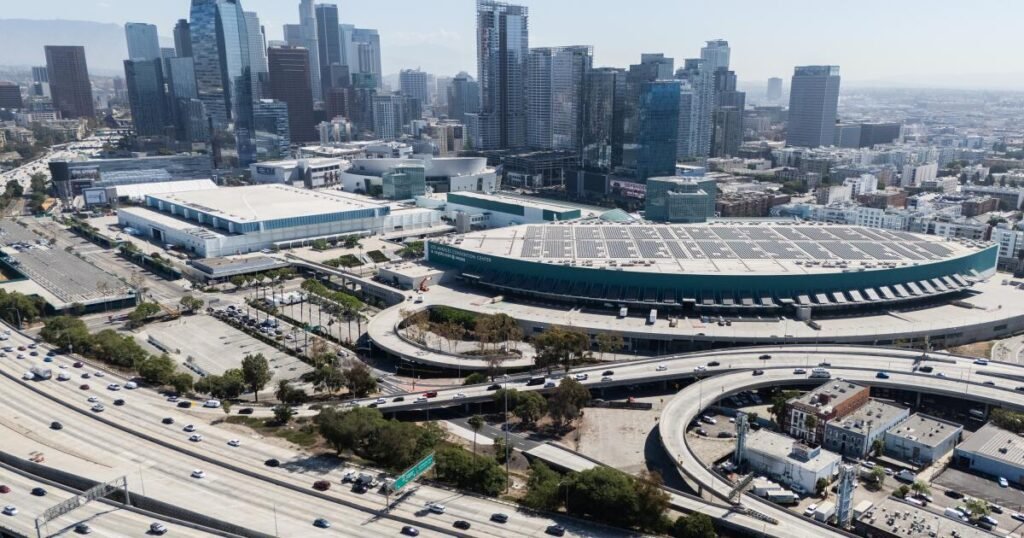Los Angeles Convention Center Expansion Plans in Jeopardy
A $2.7 billion proposal to expand the Los Angeles Convention Center is facing challenges after a city council committee, in a close vote, opted to endorse a smaller repair package instead.
Concerns are mounting that the expansion may divert funds from essential urban services. The Budget and Finance Committee voted 3-2 to pursue a more affordable upgrade plan, scheduled for completion ahead of the 2028 Olympics.
Committee Chair Katy Yaroslavsky expressed her worries about the expansion plan, which would add around 325,000 square feet to the venue straddling Pico Boulevard. She noted the financial risks associated with the project, including potential layoffs to fund its costs.
“The financial implications for the city are significant,” Yaroslavsky stated. “We may find ourselves in a position of cutting our workforce to cover expenses related to this project.”
Yaroslavsky’s alternative plan received support from councillors Bob Blumenfield and Eunisses Hernandez, while Tim Makosker and Heather Hutt opposed it, arguing it deviates too sharply from the original expansion proposal.
Hutt voiced her discomfort with the decision, saying, “There hasn’t been enough transparency. Last-minute changes are concerning, especially when they haven’t been fully vetted.” Public comments on these crucial alterations were not allowed.
Both the cheaper upgrade and repair suggestions are set to go before the full city council on Friday.
Last year, the council sought to double the adjacent meeting space in hopes of expanding the convention center, but faced a dire ultimatum to make decisions soon.
Sharon Tsuso, a legislative analyst, cautioned that the initial phase of the expansion may not be ready in time for the Olympic events, which include judo and fencing.
Tsuso also pointed out that the project’s long-term expenses could hinder the city’s ability to recruit more firefighters and police officers, as well as cover basic services like street maintenance. A budget was proposed four months ago to address a $1 billion financial shortfall, which included potential staff cuts.
“We’ve gone through a tough budgeting process,” she remarked. “If you’re satisfied with the current level of services, this project might not be the right move for you.”
At City Hall, many believe the convention center is overdue for upgrades—things like new elevators, escalators, restrooms, and overall aesthetic improvements. An expanded facility could attract larger events and conferences.
If approved, the project would link to the convention center’s South Hall, which features a distinctive green exterior visible from the major highways. Unfortunately, the design is currently outdated.
The council has been exploring various cost-cutting options, such as eliminating the plaza on Figueroa Street, and Mayor Karen Bass hopes to boost revenue by introducing digital billboards.
Even with these new advertising opportunities, estimates suggest that expanding and maintaining the convention center could cost up to $160 million by 2031, according to Matt Zabo, a senior budget analyst.
Zabo’s updated figures indicate that taxpayers may be looking at an average of around $100 million annually over the next 30 years for the expansion.
This undertaking has become crucial for various business and labor groups, who argue that Downtown Los Angeles needs economic revitalization. The area has struggled significantly post-pandemic, with many shops and eateries closing down and ongoing homelessness issues.
“We want to see Downtown thrive again; it matters to Angelenos,” one local leader expressed. “This could be the catalyst.”
Community representatives emphasized the city’s history of creating plans for convention center upgrades but often failing to follow through when the time comes to act.
“We’ve invested over a decade of research into this,” asserted Nella McOsker, head of the Central City Association. “Every delay just adds to the cost.”
Interestingly, Makoskar, who opposed the repair plan, vocalized support for expansion, pointing out that the city bore similar financial risks when building the convention center’s South Hall three decades ago.
Yaroslavsky also expressed concern that resources might be drained from the Water and Power Department for this project.
Dave Hanson, a senior assistant manager at the DWP, warned that assigning workers to the convention center could delay other significant projects, including the San Fernando Valley Light Rail initiative.
“We may end up postponing other vital projects,” Yaroslavsky noted, reflecting on the uncertainty surrounding funding and resource allocation.
Yaroslavsky’s alternative proposals encourage the city to re-evaluate approaches for expanding the convention center and exploring other methods to maximize economic benefits.
Hernandez mentioned that council members remain receptive to discussing expansion as they prepare for the final vote. “We’re not closing the door on any options,” she said. “We’re broadening the conversation.”







